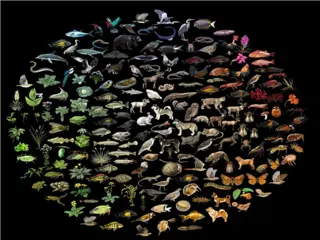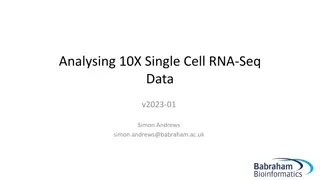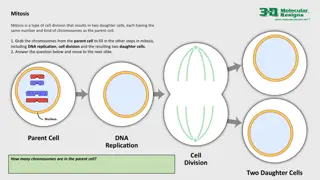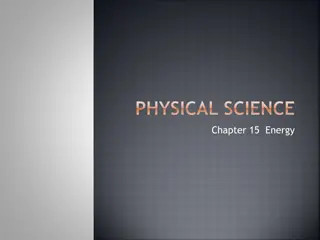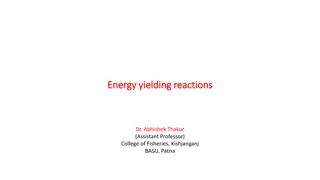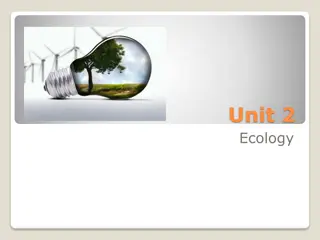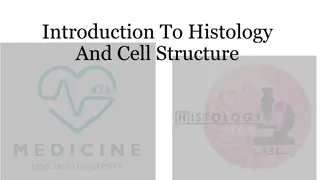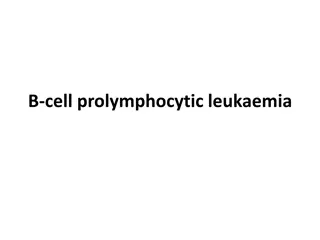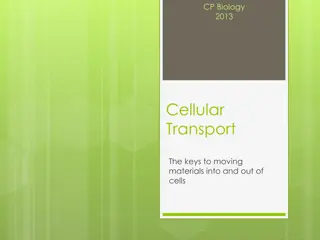Understanding Cell Processes and Energy
Explore the fundamentals of cell processes and energy, including the concepts of elements, compounds, organic and inorganic compounds, carbohydrates, lipids, proteins, and enzymes. Learn about the essential role of water and the significance of different types of compounds in living organisms.
Download Presentation

Please find below an Image/Link to download the presentation.
The content on the website is provided AS IS for your information and personal use only. It may not be sold, licensed, or shared on other websites without obtaining consent from the author. Download presentation by click this link. If you encounter any issues during the download, it is possible that the publisher has removed the file from their server.
E N D
Presentation Transcript
Chapter 3 Cell Processes & Energy
Element any substance that cannot be broken down into simpler substances. Smallest unit of an element is an ATOM. (H, O)
Compound Formed when 2 or more elements chemically combine. H20, C02, NaCl Smallest unit of a compound is a molecule.
Water Most chemical reactions within cells need water. Water helps cells keep their size/shape & keeps the cell s temp stable (no rapid changes).
Organic Compounds Compounds that contain carbon that came from living things. Many of the compounds found in living things contain the element carbon. Carbohydrates, proteins, lipids, & nucleic acids are important groups of organic compounds in living things.
Inorganic Compounds Compounds that do not contain the element carbon.
Carbohydrates An energy-rich organic compound made of the elements carbon, hydrogen, & oxygen. Sugars, starches Important components to a cell s cell wall & cell membrane
LIPIDS Energy rich organic compounds made of hydrogen, carbon, & oxygen. Fats, oils, & waxes Contain more energy than carbohydrates Cells store energy in lipids for later use.
PROTEINS Large, organic molecules made of carbon, hydrogen, oxygen, nitrogen, & in some cases sulfur. Protein molecules are made of smaller molecules called amino acids. Makes up the structure of the cell.
Enzyme A type of protein that speeds up a chemical reaction in a living thing. Without enzymes, many chemical reactions that are necessary for life would either take too long or not occur at all.
Nucleic Acids A long organic molecule made of C, O, H, N, & phosphorus. Contain the instructions the cells need to carry out all the functions of life. DNA (Deoxyribonucleic acid) & RNA (Ribonucleic acid).
DNA The genetic material that carries information about an organism that is passed from parent to offspring & directs all of the cell s functions.
RNA Plays an important role in the production of proteins. Found in cytoplasm and nucleus of cell.
Section 2 THE CELL in its Environment
Cell Membrane A permeable layer (allows things to pass through). Oxygen, food molecules, & waste products all pass through.
Movement In/Out of Cell Substances can move in & out of the cell in 3 ways: Diffusion, Osmosis, or Active Transport.
Diffusion The process by which molecules tend to move from an area of higher concentration to an area of lower concentration. Main method by which small molecules over across the cell membrane.
Concentration The amount of a substance in a given volume.
Diffusion Caused by particles moving & colliding. Collisions cause molecules to push away from one another & spread out.
Molecules diffuse through the cell membrane into a cell when there is a higher concentration of molecules outside the cell than inside the cell.
OSMOSIS The diffusion of water molecules through a cell membrane. Cells cannot function properly without water so many cellular processes depend on OSMOSIS!
Osmosis Movement Water molecules move by diffusion from an area of high concentration (area of many) to an area of low concentration (area of few).
Passive Transport Movement of dissolved materials through a cell membrane without cellular energy. Diffusion & Osmosis
Active Transport Movement of materials through a cell membrane using cellular energy. When a cell needs to take in materials that are in high concentration inside the cell than outside the cell, the movement of materials requires ENERGY.
Moving materials by Active Transport 1.Pick up- proteins in the cell membrane pick up molecules outside the cell & carry them in. 2.Engulfing- cell membrane wraps around a particle & engulfs it (may form a vacuole within the cell).
CYTOPLASM Once the material passes through the cell membrane, it is carried to its destination by a stream of moving cytoplasm. The bigger the cell the longer it takes for the material to reach its destination.
Section 3 Photosynthesis
Photosynthesis The process by which a cell captures energy from the sun & uses it to make food. Nearly all living things obtain their energy either directly or indirectly from energy from the sun. Grass makes own food (photosynthesis), zebra eats grass, lion eats zebra ..
Autotroph An organism that makes its own food. Plants
Heterotroph Organism that can t make its own food. Most heterotrophs obtain food by eating other organisms. Animals-lions, humans
The Process of Photosynthesis Plants use energy from the sun & convert carbon dioxide & water into oxygen & sugars. 2 Stage Process: 1. Capturing the sun s energy 2. Using the energy to make food.
1. Capturing the Sunlight Leaves- Chloroplasts in plant cell capture the sun s energy (absorb light). Color comes from chemical compounds in chloroplasts. Main pigment in chloroplasts is chlorophyll. It captures sunlight (solar cell) & produces sugars.
2. Using Energy to Make Food Cell needs Carbon Dioxide & Water. Carbon dioxide enters through leaf openings (stomata). Water enters through the plant roots. Both move into the chloroplasts where a series of chemical reactions occur to produce sugar & oxygen (PRODUCTS).
Plant cells use sugar for food & to make other compounds. They also store the sugar. Oxygen exits the plant through the leaves. 6C02 + 6H20 C6H12O6 + 6O2
Respiration The process by which cells obtain energy from glucose (an energy-rich sugar). Cells break down food molecules & release the energy they contain. Cells store/use energy like we deposit/withdraw money $$ from a bank.
Importance of Respiration Because all living things need a continuous supply of energy, the cells of all living things carry out respiration continuously.
Steps of Respiration 1. Glucose molecules are broken down into smaller molecules in the cytoplasm of cell. Oxygen not involved, little energy released. 2. Small molecules are broken down more in the mitochondria by chemical reactions & oxygen & lots of energy is released.
Products of Respiration Carbon Dioxide & Water. Organism uses oxygen & releases carbon dioxide.
Fermentation An energy-releasing process that allows cells to obtain their energy without using oxygen. EX: yeast & single celled organisms Alcoholic fermentation alcohol is one of the products when organism breaks down sugars. EX: when your body s muscles run out of oxygen- lactic acid is formed. (weak/sore)
Cell Cycle The regular sequence of growth & division that cells go under. It grows, prepares for division, & divides into 2 new cells. 3 Stages: Interphase, Mitosis, & Cytokinesis.
Interphase 1ststage, period before cell division. Cell grows, makes a copy of its DNA, & prepares for dividing into 2 cells. Grows to full size & grows all the important structures.
Replication Process where the cell makes an exact copy of the DNA in its nucleus. DNA holds all the info the cell needs to carry out its functions. The new daughter cell needs that DNA to survive & function.
At the end of Replication in the Interphase, the cell is ready to divide!
Stage 2 Mitosis The stage during which the cell s nucleus divides into 2 new nuclei. DNA is distributed to each cell. 4 Parts of Mitosis: prophase, metaphase, anaphase, & telophase.



































